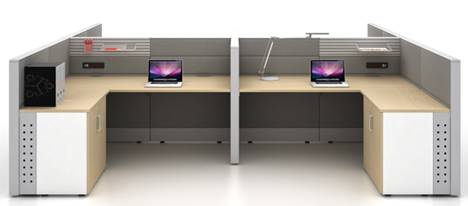Office Furniture for the Future: Adaptable Designs for Flexible Workstyles
In today's rapidly evolving work landscape, where remote work and flexible schedules are becoming the norm, traditional office spaces are undergoing a significant transformation. As organizations strive to create dynamic and productive work environments, the need for adaptable office furniture and flexible workplace design is more critical than ever. In this blog post, we will explore the concept of flexible workplace design, its importance, and the key elements that contribute to creating a versatile and adaptable office space.

What Is Flexible Workplace Design?
Flexible workplace design refers to the intentional and strategic creation of office spaces that can easily adapt to accommodate the changing needs and preferences of employees. It is a departure from the traditional fixed layouts and rigid workstations, aiming to provide a dynamic environment that supports various work styles, promotes collaboration, and enhances productivity.
Flexible workplace design recognizes that different tasks require different settings and that individuals have unique work preferences. It allows employees to choose from a variety of workspaces based on their specific needs, whether it's a quiet area for focused work, a collaborative space for team projects, or a comfortable lounge for informal meetings. The design incorporates versatile furniture, movable partitions, and adaptable layouts to enable easy reconfiguration and customization of the workspace.
Flexible workplace design goes hand in hand with the changing nature of work, where organizations are increasingly recognizing the value of employee autonomy, work-life balance, and the need for creative and collaborative environments. It promotes employee satisfaction, well-being, and engagement, ultimately leading to increased productivity and innovation within the organization.
Why Does a Flexible Office Design Matter?
The concept of a flexible office design revolves around creating a workspace that can adapt to the changing needs and preferences of employees. A flexible office design matters for several reasons:
-
Enhanced Productivity: By offering a range of workspaces tailored to different tasks, flexible office design promotes productivity. Employees can choose an environment that suits their work requirements, whether it's a quiet area for focused tasks or a collaborative space for team projects. This flexibility empowers individuals to work at their best, leading to increased productivity and efficiency.
-
Improved Collaboration: Collaboration is a cornerstone of modern workplaces. Flexible office design fosters collaboration by creating spaces that encourage interaction and teamwork. By incorporating movable furniture, writable surfaces, and collaborative tools, employees can effortlessly come together to share ideas, solve problems, and innovate.
-
Employee Satisfaction and Well-being: A flexible office design demonstrates an organization's commitment to employee well-being. It allows individuals to have control over their work environment, leading to higher job satisfaction. Additionally, incorporating ergonomic furniture, natural elements, and spaces for relaxation and rejuvenation promotes physical and mental well-being, reducing stress and increasing overall happiness.
-
Attraction and Retention of Talent: In today's competitive job market, organizations that offer flexible work environments are more appealing to potential employees. A well-designed, adaptable office space signals a progressive and forward-thinking company culture, attracting top talent and improving employee retention rates.
What Are the Elements of Flexible Office Design?
The need for adaptable work environments and flexible office design has emerged as a vital concept. This design philosophy focuses on creating office spaces that can easily adapt to the changing needs and preferences of employees.
-
Multi-functional Spaces: A flexible office should feature multi-functional spaces that can be easily transformed to accommodate different activities. These spaces can include open areas for collaboration, private pods for focused work, meeting rooms with movable walls, and breakout zones for informal discussions.
-
Modular Furniture: The use of modular furniture allows for easy reconfiguration and customization of the workspace. Modular desks, tables, and partitions can be rearranged to accommodate different team sizes and project requirements, providing employees with the flexibility to adapt their workstations as needed.
-
Ergonomic Solutions: Prioritizing ergonomic furniture is crucial for employee well-being and productivity. Adjustable desks, chairs, and monitor arms enable individuals to personalize their workstations, promoting good posture and reducing the risk of musculoskeletal issues.
-
Technology Integration: Integrating technology seamlessly into office furniture enhances connectivity and productivity. Built-in power outlets, wireless charging pads, and cable management systems eliminate clutter and make it easier for employees to connect and charge their devices. Additionally, incorporating smart features like adjustable lighting and temperature control can improve comfort and efficiency.
-
Versatile Storage Options: Adequate storage solutions are essential for maintaining an organized and clutter-free workspace. Versatile storage options such as modular cabinets, lockers, and shelving units can be easily adjusted to meet changing needs, accommodating individual and team storage requirements.
-
Biophilic Design: Bringing elements of nature into the office space has been shown to improve employee well-being and creativity. Incorporating biophilic design elements such as natural lighting, living walls, plants, and natural materials can create a connection with the outdoors and enhance the overall ambience.
-
Acoustic Solutions: To balance the need for collaboration and privacy, flexible office design should include acoustic solutions. Movable acoustic panels, sound-absorbing materials, and private enclosures help create quiet spaces for focused work and minimize distractions in open areas.
Conclusion
As the nature of work continues to evolve, the design of office furniture and workspaces must adapt accordingly. Flexible workplace design, with its emphasis on adaptability, collaboration, and employee well-being, is key to creating productive and engaging office environments. By incorporating elements such as multi-functional spaces, modular furniture, ergonomic solutions, technology integration, versatile storage options, biophilic design, and acoustic solutions, organizations can future-proof their offices and provide an environment that supports flexible workstyles and the changing needs of their employees.
- 19.06.2023